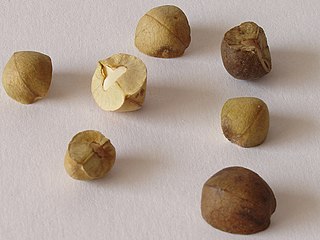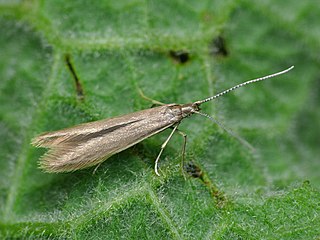
A pupa is the life stage of some insects undergoing transformation between immature and mature stages. Insects that go through a pupal stage are holometabolous: they go through four distinct stages in their life cycle, the stages thereof being egg, larva, pupa, and imago. The processes of entering and completing the pupal stage are controlled by the insect's hormones, especially juvenile hormone, prothoracicotropic hormone, and ecdysone. The act of becoming a pupa is called pupation, and the act of emerging from the pupal case is called eclosion or emergence.

Helicoverpa zea, commonly known as the corn earworm, is a species in the family Noctuidae. The larva of the moth Helicoverpa zea is a major agricultural pest. Since it is polyphagous during the larval stage, the species has been given many different common names, including the cotton bollworm and the tomato fruitworm. It also consumes a wide variety of other crops.

The Tortricidae are a family of moths, commonly known as tortrix moths or leafroller moths, in the order Lepidoptera. This large family has over 11,000 species described, and is the sole member of the superfamily Tortricoidea, although the genus Heliocosma is sometimes placed within this superfamily. Many of these are economically important pests. Olethreutidae is a junior synonym. The typical resting posture is with the wings folded back, producing a rather rounded profile.

The apple maggot, also known as the railroad worm, is a species of fruit fly, and a pest of several types of fruits, especially apples. This species evolved about 150 years ago through a sympatric shift from the native host hawthorn to the domesticated apple species Malus domestica in the northeastern United States. This fly is believed to have been accidentally spread to the western United States from the endemic eastern United States region through contaminated apples at multiple points throughout the 20th century. The apple maggot uses Batesian mimicry as a method of defense, with coloration resembling that of the forelegs and pedipalps of a jumping spider.

Mexican jumping beans are seed pods that have been inhabited by the larva of a small moth and are native to Mexico. The pod is usually tan to brown. They are from the shrub Sebastiania pavoniana, often also referred to as "jumping bean". However, they are not related to actual beans, but rather to spurges. The beans are considered non-toxic but are not generally eaten. In the spring, when the shrub is flowering, moths lay their eggs on the shrub's hanging seedpods. When the eggs hatch, tiny larvae bore into the immature green pods and begin to devour the seeds. The pods ripen, fall to the ground and separate into three smaller segments, and those segments are called Mexican jumping beans. As the tiny larvae inside curl up and uncurl, they hit the capsule's wall with their heads – and the bean jumps. They move more as temperatures rise, the larva eats away the inside of the bean and attaches itself to the inside of the bean with silk-like thread.

The codling moth is a member of the Lepidopteran family Tortricidae. They are major pests to agricultural crops, mainly fruits such as apples and pears, and a codling moth larva is often called an "apple worm". Because the larvae are not able to feed on leaves, they are highly dependent on fruits as a food source and thus have a significant impact on crops. The caterpillars bore into fruit and stop it from growing, which leads to premature ripening. Various means of control, including chemical, biological, and preventive, have been implemented. This moth has a widespread distribution, being found on six continents. Adaptive behavior such as diapause and multiple generations per breeding season have allowed this moth to persist even during years of bad climatic conditions.

Spirostachys africana is a medium-sized deciduous tree with a straight, clear trunk, occurring in the warmer parts of Southern Africa. Its wood is known as tamboti, tambotie, tambootie or tambuti.

Cydia is a large genus of tortrix moths, belonging to the tribe Grapholitini of subfamily Olethreutinae. Its distinctness from and delimitation versus the tribe's type genus Grapholita requires further study.

Archips podana, the large fruit-tree tortrix, is a moth of the family Tortricidae. The species was first described by Giovanni Antonio Scopoli in his 1763 Entomologia Carniolica. It is found in Europe, Asia from Anatolia to Japan and is an introduced species in North America.

Eupackardia is a monotypic moth genus in the family Saturniidae erected by Theodore Dru Alison Cockerell in 1912. Its only species, Eupackardia calleta, the calleta silkmoth, was described by John O. Westwood in 1853. It is found in Mexico, Guatemala, as well as in the states such as; Arizona, New Mexico, and Texas.

Coleophora caespititiella is a moth of the family Coleophoridae. This species is found throughout the United Kingdom and most of Europe. It is also known from North America. The Coleophoridae group are often collectively known as the case moths or case-bearers.
Anatrachyntis rileyi, the pink cornworm, pink bud moth or pink scavenger, is a species of moth of the family Cosmopterigidae, the cosmet moths. It was first described by Lord Walsingham in 1882 from the southern United States, but it is probably an introduction to North America. It is found in much of the warm or tropical areas of the world, including northern Australia, the Galápagos Islands, Hawaii, the Antilles, South America and Mauritius.

Cadra figulilella, the raisin moth, is a moth of the family Pyralidae. The raisin moth is known most commonly as a pest that feeds on dried fruits, such as the raisin and date. It covers a range that includes much of the world, primarily situating itself in areas of California, Florida, the Eastern Mediterranean region, and some parts of Africa, Australia, and South America. The moth prefers to live in a hot, arid climate with little moisture and plentiful harvest for its larvae to feed on. Study of this species is important due to the vast amount of economic damage it causes yearly and worldwide to agriculture crops.
Cydia parapteryx is a moth of the family Tortricidae. It was first described by Edward Meyrick in 1932. It is endemic to the Hawaiian island of Oahu.
Adoxophyes privatana, the appleleaf-curling moth, is a moth of the family Tortricidae. The species was first described by Francis Walker in 1863. It is native to south-east Asia, where it has been recorded from Taiwan, Hong Kong, Hainan in China, Nepal, India, Sri-Lanka, Thailand, Vietnam, western Malaysia, Singapore, Sumatra, Java, Borneo, the Philippines and the Chagos Archipelago. It is an accidental introduction in Great Britain.

Cadra calidella, the dried fruit or date moth, is a species of snout moth in the genus Cadra and commonly mistaken for the species Cadra figulilella. It thrives in warmer conditions and is found primarily in Mediterranean countries, although it can also be found in Central Asia, Kazakhstan, Transcaucasia, Caucasus, and the western part of Russia. It feeds on dried fruits, carobs, nuts and seeds, hence earning its colloquial name. This diet damages the food industry, and it is a common storage pest. Because of this, much research has been done to study ways to limit its reproduction rate and population size. It was first described by Achille Guenée in 1845.
Emporia melanobasis is a species of snout moth in the genus Emporia. It was described by Boris Balinsky in 1991, and is known from South Africa.

Cydia servillana is a moth of the family Tortricidae which forms galls on the young shoots of willow. It was first described by Philogène Auguste Joseph Duponchel in 1836.

Sebastiania pavoniana is a species of tree in the spurge family native to Mexico and northwest Costa Rica. It is the 'bean' part of the Mexican jumping bean, despite not being a legume like true beans. The 'jumping' is provided by the larva of the jumping bean moth.
Mahasena corbetti, the coconut case caterpillar, is a polyphagous species of bagworm. This species is classified as leaf-eating pest caterpillars that produce tough silk out of their bags from dried foliage. Currently, M. corbetti is considered a 'pest of quarantine importance' in multiple countries and is included on the list of dangerous pests in the Malaysian plant quarantine act.

















